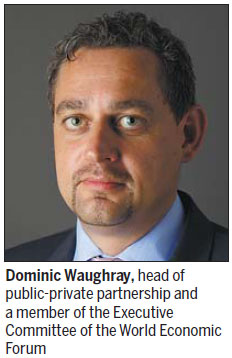Charting a new course for growth
Editor's note: More than 1,700 participants from 90 countries are attending the Summer Davos in Dailian, Liaoning province, from Wednesday to Friday. Their discussions will focus on transformational science, industry disruption, economic uncertainty, China's "new normal", environmental boundaries and "being human". Below four participants look at the influence of technology and innovation on economic growth.
Data will shape future energy consumption

Although in the evolution of humanity, securing access to energy has been a critical enabler of development and improving quality of life. Thus secure and sustained energy access has been the primary objective of people responsible for energy systems.
Beyond access, energy cost and affordability was the second priority for energy planners across the world, and now, relatively recently in the context of history, environmental sustainability has become the third leg of what we call the energy triangle.
What an energy system has to deliver to society is, in fact, secure access to sustainable and affordable energy, and what binds together these three elements is technology.
There are currently six critical factors that are affecting energy system transformations: modern technology, which is enabling the decoupling of economic growth from energy consumption; the digitization of energy systems; growing environmental awareness; the maturing of renewable energy to become mainstream in the energy portfolio; accelerating urbanization; and the increasing demand for better quality of life and energy from the expanding global middle class.
This requires a long-term vision and courage to take steps that may be costly in the short term but which will be beneficial toward long-term peace. The investment decisions taken today in energy and infrastructure will have an impact on society in the next 15 to 25 years.
For more sustainable energy use, it is not the abundance of resources but the abundance of data that is now the name of the game.
New technologies enable countries to reduce the amount of energy lost during transmission, intelligent distribution systems enable a more efficient calculation and use of energy supplies, and digital devices allow users to switch their energy use on and off at "just the right time".
In the recent past, China has led the world in rapidly enabling energy access to a fast growing population. The relatively low price of oil has made its relative affordability an opportunity for investments, instead of a necessity, in a world where the focus on sustainability is becoming increasingly relevant.
China's challenge now is to advance both technology and behavior to boost the next phase of economic and social development. The key to this is to take advantage of the opportunity presented by current conditions to make large-scale investments in technology focusing on innovation in sustainability.
For energy in particular, the opportunity to innovate both in technology and behavior will enable a better use of energy and a different way of conceiving energy.
A better use of energy means leveraging existing and new technologies to enable energy efficiency and conservation at scale.
The peak of energy consumption can be reduced by the intelligent use of data and adapting behavior to a new model that is not only centered on individual needs but also collective consciousness and optimization.
Technology can also render current energy transmission systems far more efficient. Energy lost in long transmission lines can be reduced thanks to new technologies and because energy production and consumption are closer through distributed energy.
A different way of conceiving energy means changing how and what we measure in terms of energy.
Most energy systems focus on the supply side of the value chain, always ensuring sufficient energy, at any time, the critical factor being to deliver enough to meet the demand. Thanks to digitization, technology can now switch the focus to the benefits that energy provides rather than just the supply.
This is the great opportunity for China in a new era in which rapid technology innovation will have to be combined with a change in consumption behavior to deliver a fair and better society for everyone.
Can China innovate on both technology and behavior, bringing them together to boost the next phase of economic and social development? Any change China makes will certainly have a global impact, and the right combination will place it in a leadership position.
Opportunity to reinforce a sustainable tomorrow

In the runup to the Paris Climate Conference in December 2015, much attention has focused on the US-China alignment on climate change. The joint announcement made by the two countries last year has been lauded as the watershed moment when the world's two largest economies and emitters of greenhouse gases began leading the international community in tackling rising emissions.
By 2025, the United States has pledged to reduce emissions by between 26 and 28 percent of 2005 levels, while China has pledged to peak its emissions by 2030. In June, Premier Li Keqiang announced goals to extend China's cut in carbon intensity to about 60 percent of 2005 levels by 2030.
China has made public its climate intentions well in advance of the Paris conference. Avoiding a repeat of Copenhagen in 2009 - the previous attempt to secure a global agreement on climate change - is clearly a must, but economic shifts are also fast reshaping China's outlook on climate change.
In recent months, China's leaders have coined the phrase "the new normal" when describing the changing realities for the future of China's economy. This vision depicts China's transition into a period of slower but more sustainable growth, driven by domestic consumption rather than exports and investment.
Evidence of the environmental damages caused by the country's untrammelled economic activities abound. According to the Ministry of Environmental Protection, only one-tenth of the major cities in China that are monitored met the national clean air standards in 2014. The recent tragedy in Tianjin further highlighted the triple threats posed by water, air and soil pollution.
Clearly, getting China cleaner is a formidable challenge. The legal framework continues to play catch-up, and enforcement remains very difficult. The MEP said that there were over 25,000 violations and 9,324 companies shut down since the new Environmental Protection Law took effect this year.
Despite the recent amendments to the air pollution law, increased resources for environmental inspection and a reported 100 million yuan ($15.73 million) invested in an online monitoring system, it will not be easy to rein in polluting industries.
The heart of the matter is how fast China can move away from its current nationwide coal-dependent development trajectory to avoid further environmental damage.
New coal-fired power plants may have been banned in the more advanced eastern parts, with the introduction of more stringent air quality targets introduced, but the planned ultra-high voltage transmission lines to the eastern and southeast regions are still under consideration, which would likely lead to coal power generation in the less-developed provinces feeding the rest of the country in the years ahead.
However, there is promise that China will be able to wean itself away from its coal dependency. China is no stranger to policies and incentive schemes that drive clean energy investments.
There was already a goal to meet 15 percent of China's power needs from renewable sources by 2020, which has been updated to 20 percent by 2030 in the joint announcement. And just under one-third of all global renewable energy investment went to China in 2014.
Today, wind energy is powering more than 110 million homes - from nearly zero a decade back. And as home to 75 percent of the world's solar manufacturing, the country also has an important stake in the booming solar industry.
Meanwhile, the government has put in place carbon trading pilots spanning seven cities and provinces (Beijing, Chongqing, Shanghai, Shenzhen, Tianjin, Guangdong and Hubei) since 2011.
Elements for a national carbon market plan have been gradually introduced over the past year. The anticipation is that carbon trading will increasingly play an important role in incentivizing cleaner infrastructural choices and in controlling emissions.
Choices made in China matter, especially when it comes to the world's ability to tackle global challenges like climate change and resource security.
The good news is that Chinese leaders appear to be embracing a vision for China's future that is not only about economics but also intertwined with stronger environmental outcomes.
The 13th Five-Year Plan (2016-2020), is a great opportunity for China to clarify and reinforce its plan for a sustainable future, one that neither China nor the rest of the world can afford to miss.
Precision medicine promises new age of healthcare

With our growing knowledge and understanding of genetics growing, two things have become clear. First, people's genetic differences can lead to different responses to treatments. Second, more precise, personalized treatment plans could improve patient health outcomes and reduce healthcare costs significantly.
The cost of healthcare has consistently outpaced economic growth by 2 percent on average in the Organization for Economic Cooperation and Development countries over the past 50 years. The continued growth of precision medicine can help curb this trend.
When applied to individualized chronic disease management, it can reduce hospital admissions and speed up discharge through integrated care solutions and personalized treatment plans adjusted in real time.
And thanks to remote monitoring solutions, care could be provided in lower acuity settings, including the home.
Fast progress in genomics, proteomics (the science that explains how messenger molecules use genome information to trigger the production of proteins), gene therapies and regenerative medicine is being made, paving the way for the continued growth of this exciting field of medicine.
Advances in 3-D bioprinting technology from companies such as Organovo have led to the creation of tissues that mimic key aspects of native tissues.
As a result, we may soon see the end of animal and human tissue use in clinical trials. In the longer term, it could create opportunities to "copy and paste" a patient's tissues to create replacement organs from their own cellular material, further eliminating the need to determine compatibility with the receiver.
Genome editing has emerged as one of the most exciting new areas of scientific research.
Recent advances have made it possible to modify, in a targeted way, almost any gene in the human body with the ability to directly turn on, turn off or edit disease-causing genes.
There is hardly anything more targeted than modifying your own genome to eliminate the cause of the disease, as opposed to simply addressing the symptoms.
And tests are now able to survey the antibodies present in a person's bloodstream to reveal a history of the viruses they've been infected with throughout their life. This could be useful not only for diagnosing current and past illnesses, but for developing vaccines and studying links between viruses and chronic disease.
Additionally, the history of viral infection revealed by these tests can help to better explain host immunity and better target treatments for complex diseases such as Type I diabetes, inflammatory bowel disease and asthma.
Digital medicine platforms such as those being developed by Proteus Digital Health are improving our monitoring and measuring of medication adherence during treatment plans.
Platforms being built today include measurement tools such as sensor-enabled pills, a peel-and-stick biometric sensor patch worn on the body and smartphone apps. The patch records when a pill is ingested and also tracks other things such as sleep patterns and physical activity levels.
Monitoring real-time compliance to treatment, and ultimately the ability to correlate compliance with improvement in vital signs, could well be another critical tool to constantly adjust treatment protocols that ultimately create the best possible patient outcome.
These innovations point to the potential for a new age in healthcare, one of personalized medicine that can improve patient health outcomes and reduce healthcare costs to sustainable levels.
However, we need some big changes in regulatory frameworks, pricing models and doctor incentive systems to make this new paradigm of healthcare possible.
Collaborations for global good

For nine years, the Summer Davos meeting in China has provided an informal venue for leaders in cutting-edge innovation, science and technology to meet and discuss the pressing issues of the day.
The concept is simple: From a diverse gathering of business innovators and science and technology leaders, new collaborations for the global good can be formed. So what can we expect from the meeting in China? How can the world's top entrepreneurs build partnerships with policymakers, industry leaders and nongovernmental organizations?
There is already a great deal to build on. Consider the greenhouse gas emissions cap that China has announced, or China's national Internet Plus strategy, which is aimed at rejuvenating traditional industries and helping to drive economic growth by integrating Internet technologies with manufacturing and business, or scaling the circular economy, which promotes a way of doing business that tries to decouple economic growth from the overuse of resources, all the while creating jobs.
The Summer Davos offers great opportunities to help advance some of this agenda.
The idea has worked in the past: six years ago, El Nio brought the worst drought in four decades to India and South Asia. Many at the 2009 Summer Davos were asking how countries could secure the food they needed, given the high levels of water stress and drought many were facing.
New partnerships were clearly required that could bring together innovators from across the business community to support governments in facing this challenge.
That year, the chief minister of Karnataka, the ninth largest state in India with a population of 60 million and a huge shortfall in water for urban needs, met with industry leaders and took a visionary step to develop a new partnership with the innovative Water Resources Group, a partnership incubated by the World Economic Forum in collaboration with the International Finance Corp.
The partnership has mobilized $300 million in investment and has now matured to a state-wide program to promote drip irrigation for sugar cane. Business innovators and technology providers have joined forces with the government and farmers and are helping to drip irrigate 1 million hectares of sugar cane across the state to the benefit of 700,000 farmers, and, crucially, saving 2.6 billion cubic meters of water a year that can be used to serve towns or support much-needed high-value industrial activities.
Closing the infrastructure gap is another global challenge being championed by the World Economic Forum where much activity and partnership have also taken place. New models for public-private project preparation facilities, blended finance and long-term investment models have been developed.
At a recent United Nations Financing for Development Conference in Addis Ababa, Ethiopia, the forum, in collaboration with the Organization for Economic Cooperation and Development and a coalition of public-private actors, launched three blended finance initiatives to help meet the United Nations Sustainable Development Goals.
Included is a Sustainable Development Investment Partnership between governments and financial institutions aimed at unlocking private capital for sustainable infrastructure and other development needs.
These models can be highly appropriate for the challenges facing China today, as growth slows and more innovative public-private ways to fund its infrastructure gap are needed. For example, much potential could be found in exploring the list of more than 1,000 projects that China's National Development and Reform Commission presented for public-private partnership in May, in sectors such as transport, water conservancy and public services.
With its new status as the international institution for public-private cooperation, the forum is committed to providing an impartial and trusted platform for this type of public-private collaboration.
The hope is that this will increase understanding among the public and private sector about the key issues driving the global agenda, as well as identifying and catalyzing innovative new solutions to improve them through public-private cooperation.
(China Daily 09/09/2015 page24)














